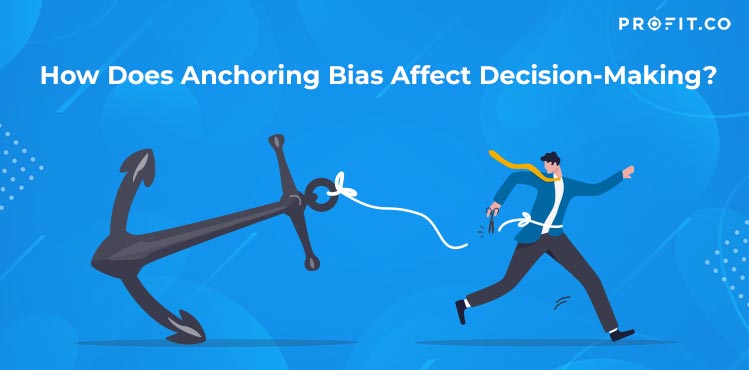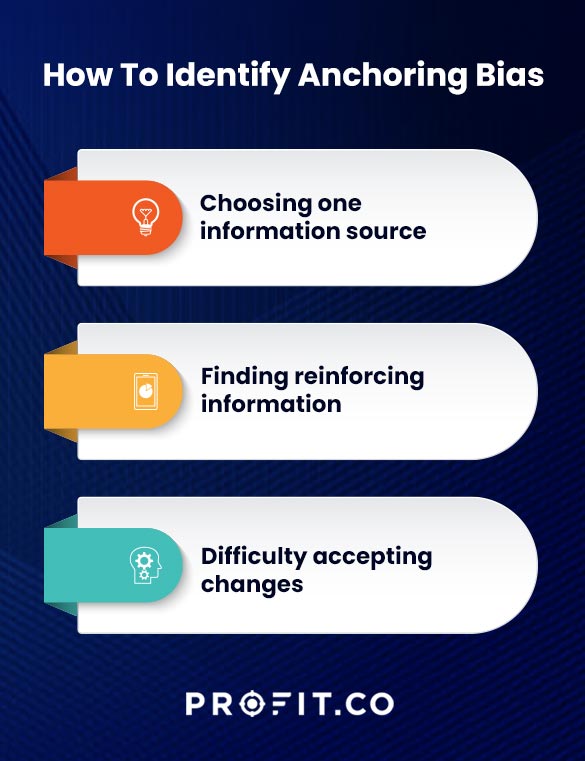Ask anyone about their life expectancy: how long do they think they’ll live? The most common answers involve parents and grandparents. If they lived for over 100 years, you expect longevity. Is this accurate?
We use our parents’ age as an anchor or reference point for our expectations. Unfortunately, we ignore that our current lifestyle is more sedentary and unhealthier than theirs. This is an example of anchoring bias, which has a powerful impact on decision-making.
Read this guide to learn how to identify anchoring bias and make sound choices.
What Is Anchoring Bias?
Anchoring bias is a heuristic or mental shortcut that relies on the first information you receive concerning a subject. This initial information serves as a basis or anchor to inform your choice, regardless of subsequent information.
Errors in judgment occur if we assume that the first data is correct and disregard other data sources that confirm or deny it. Anchoring bias is a confirmation bias common to all of us because it helps us make decisions faster. However, it also makes us vulnerable to skewed assumptions and expectations.
Examples of Anchoring Bias
The following are some anchoring bias examples we encounter daily.
- Pricing
Businesses often use cash amounts ending in 9 or 99 to take advantage of anchoring bias. A product that costs $599 appears cheaper than $600 because our brains would instead take the shortcut than round off the figures. A similar anchoring bias example is in discounts or offers. Retailers often add discount percentages but retain the original prices, and we anchor on the “50% off” sticker instead of checking the price tag. This is especially popular with food ordering apps to recover delivery costs.
- Budgeting
Retailers know that 66% of customers search for products online before buying. Sellers know what you’re willing to spend, so they offer anchor prices slightly lower than your budget to close the deal. This anchoring heuristic is common in real estate and vehicle purchases.
- Dieting
Restaurants typically serve more portions than one person needs to eat, which favors the anchoring bias. Large quantities alter our perception of satisfaction and value. The more we eat, the less we think we spend per serving. If we anchor on healthy portions, we will manage our intake better. For example, we could share these large portions with friends, carry leftover food, or serve the delivered meals on our regular plates rather than eating from the food packaging.
- Bidding
Online auction sites offer great deals by allowing buyers to set their starting prices. Anchoring bias may lead us to pay more than the item’s value, mainly because bidding comes with a countdown timer that heightens our anxiety.
- Investing
Another anchoring bias example is in building an investment portfolio. If investors anchor their stock value on market price alone, they fail to consider other variables affecting the stock. Such investors end up spending or holding overvalued assets or missing out on undervalued but potentially lucrative investments.
- Recruitment
Applicants with overqualified credentials can influence hiring decisions. An HR manager who first encounters a resume from a master’s qualified applicant may set it as a standard. This may lead to overlooking better-qualified applicants with diplomas or degrees with adequate and relevant experience.
- Compensation
Salary negotiations are challenging for both job seekers and employers. The first offer from either party determines the final salary, and employees often undersell themselves. Employers take advantage of anchoring bias to pay lower compensation to new workers.
I am not a product of my circumstances. I am a product of my decisions.
Why Does Anchoring Bias Affect Decisions?
The anchoring bias examples above show that it’s more common than we think. Anchoring bias affects decision-making because:
- We Have Limited Time and Energy
Some decisions require effort to determine the best course of action. Unfortunately, we use mental shortcuts like the anchoring heuristic to save time. If our initial information aligns with our expectations, we accept it as accurate and base our choices on it.
- We’re Inherently Lazy
The love of convenience encourages the anchoring bias. When we opt for the first deal or quickest offer, we lose out on good quality and value for money.
- We Underestimate Our Moods
Studies show that mood affects how we make decisions in that a positive mood leads to clearer, more consistent choices and vice-versa. A bad mood may lead to greater reliance on anchoring biases than an upbeat mood because our minds experience stress and need a shortcut to make decisions.
- We Discredit New Data
When the initial data matches our beliefs or expectations, we disregard any subsequent information that challenges it. In this way, anchoring bias reinforces other biases that affect decision-making. One of the key elements to watch about data-based decision-making is to avoid confirmation bias that promotes the tendency of people to look for information that supports their pre-existing beliefs, cherry-pick data and facts to suit their narrative, and interpret and selectively remember information in a way that confirms their assumptions.
How To Identify Anchoring Bias
Anchoring bias is more straightforward to spot than other types of preferences because it appears at the beginning of the decision-making process. Watch out for the following characteristics of anchoring bias when making choices.
- Choosing One Information Source
If you shop from one store or website, you’re likely playing to the anchoring heuristic. Even if your source is reliable, you may miss out on better products, prices, or information from competitors.
- Finding Positively-Reinforcing Information
The anchoring bias also encourages echo chambers that reinforce our existing beliefs. For example, we may hire the same real estate agents or contractors as our relatives without question or visit similar websites or platforms because of behavior-tracking algorithms.
- Difficulty Accepting Changes
If we anchor to outdated information, we find it hard to accept new data, especially regarding finances. A typical anchoring bias example is how older generations recall the low cost of living compared with today’s economy. Once we anchor to the past, we fail to accept that change is inevitable, for better or worse.
Sometimes Businesses can suffer when employees base their decisions on anchoring bias without consulting facts and data. One of the ways to keep the employees focused on goals is using an agile OKR framework to ensure the organization’s vision is tied to goals with measurable key results to keep the focus and help prioritize and make effective decisions. You can get started on Profit.co completely free today!
How Can We Overcome Anchoring Bias?
You can take practical steps to overcome anchoring bias if you notice the above traits in yourself or your loved ones when making decisions. These include:
- Window-shopping
As simple as it sounds, comparing prices can help us counter the effects of the anchoring heuristic. Whether buying groceries, gifts, or software for your business, look at multiple vendors to ensure you get good value for your money. Also, read product reviews and watch instructional videos of products you’re interested in to see if they match your expectations. If not, explore other alternatives that meet your needs.
- Due Diligence
Whether you’re vetting a new employee or choosing stocks for your portfolio, due diligence can confirm or deny the data before you make your decision. Of course, due diligence takes time, and you may need to outsource the process, but it’s worth the effort to break free of anchoring bias in critical decisions.
- Avoid Emotional Decision-Making
We should ideally remain neutral to make informed choices, but emotions are inevitable. To overcome anchoring bias due to feelings, keep these tips in mind:
- Practice mindfulness to control and reduce stress
- Compare your initial gut instinct to facts before making choices
- Give yourself enough time to assess your information and identify biases
- Sleep on the decision to give your body and mind a break
- Avoid hindsight bias
- Study Your Thinking Process
Figure out how you arrive at your conclusions to spot any anchor bias examples. Ensure your decisions have a solid foundation based on facts and values rather than irrational thoughts or biases. Journaling can help reveal your thinking process and serve as a reference for future decisions.
- Get A Second Opinion
Ask an expert for recommendations or guidelines when your decision seems to align with anchoring biases. Use objective questions and avoid offering your opinions. Compare their reasoning to your own and see if your choice is sound. Where an expert is unavailable, choose a group of trusted individuals who can give honest opinions.
- Keep an Open Mind
One theory about anchoring bias is that during uncertainty, the first information you get becomes the basis for every future judgment. This anchor colors our perception of the following information, and we choose only what supports the anchor, and this stops us from changing our minds in the face of new data. When we keep our minds open to further information or possibilities, we decrease the impact of the anchoring heuristic on our perceptions. By keeping an open mind, one can avoid cognitive dissonance in decision-making.
Conclusion
Among the many biases plaguing our decision-making, anchoring bias is one of the most critical biases influencing our decision-making process. It’s challenging to avoid the anchoring heuristic because of our stressful lives, changing economy, and digital algorithms that encourage mental shortcuts. The anchoring bias examples here show that humans think in simple or basic terms–we latch onto first impressions or initial reference points and accept them as true. Unfortunately, we must learn to analyze our thinking to identify anchoring bias and avoid making poor choices. Greater awareness of anchoring bias can reduce its influence and improve decision outcomes. Book a free demo with our team to learn more about how OKR software can optimize your organization’s performance by helping teams focus on achieving goals with the least bias.





